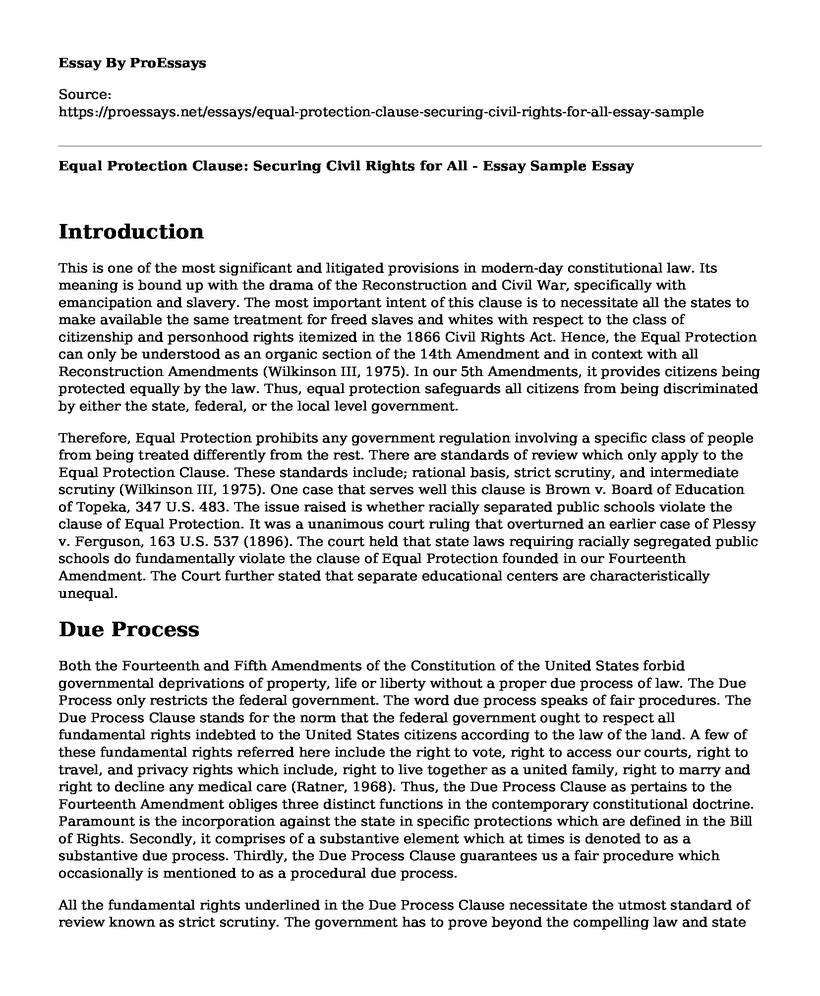Introduction
This is one of the most significant and litigated provisions in modern-day constitutional law. Its meaning is bound up with the drama of the Reconstruction and Civil War, specifically with emancipation and slavery. The most important intent of this clause is to necessitate all the states to make available the same treatment for freed slaves and whites with respect to the class of citizenship and personhood rights itemized in the 1866 Civil Rights Act. Hence, the Equal Protection can only be understood as an organic section of the 14th Amendment and in context with all Reconstruction Amendments (Wilkinson III, 1975). In our 5th Amendments, it provides citizens being protected equally by the law. Thus, equal protection safeguards all citizens from being discriminated by either the state, federal, or the local level government.
Therefore, Equal Protection prohibits any government regulation involving a specific class of people from being treated differently from the rest. There are standards of review which only apply to the Equal Protection Clause. These standards include; rational basis, strict scrutiny, and intermediate scrutiny (Wilkinson III, 1975). One case that serves well this clause is Brown v. Board of Education of Topeka, 347 U.S. 483. The issue raised is whether racially separated public schools violate the clause of Equal Protection. It was a unanimous court ruling that overturned an earlier case of Plessy v. Ferguson, 163 U.S. 537 (1896). The court held that state laws requiring racially segregated public schools do fundamentally violate the clause of Equal Protection founded in our Fourteenth Amendment. The Court further stated that separate educational centers are characteristically unequal.
Due Process
Both the Fourteenth and Fifth Amendments of the Constitution of the United States forbid governmental deprivations of property, life or liberty without a proper due process of law. The Due Process only restricts the federal government. The word due process speaks of fair procedures. The Due Process Clause stands for the norm that the federal government ought to respect all fundamental rights indebted to the United States citizens according to the law of the land. A few of these fundamental rights referred here include the right to vote, right to access our courts, right to travel, and privacy rights which include, right to live together as a united family, right to marry and right to decline any medical care (Ratner, 1968). Thus, the Due Process Clause as pertains to the Fourteenth Amendment obliges three distinct functions in the contemporary constitutional doctrine. Paramount is the incorporation against the state in specific protections which are defined in the Bill of Rights. Secondly, it comprises of a substantive element which at times is denoted to as a substantive due process. Thirdly, the Due Process Clause guarantees us a fair procedure which occasionally is mentioned to as a procedural due process.
All the fundamental rights underlined in the Due Process Clause necessitate the utmost standard of review known as strict scrutiny. The government has to prove beyond the compelling law and state interest to be narrowly custom-made to the objectives sought to be attained if any infringement of this fundamental right is applied. It thus means explicitly that, for the government to infringe one of the fundamental rights, it ought to be protecting an interest or compelling law which is of high importance such as security or safety of its citizens (Ratner, 1968). Point to note is that whatever limits are undertaken on the fundamental rights of these citizens by the government should be "narrowly tailored," denoting that these infringements have to present the minimum possible infraction upon the citizens' rights as the case of Gitlow v. New York, 268 US 652 - 1925
References
Brown v. Board of Education, 347 U.S. 483, 74 S. Ct. 686, 98 L. Ed. 873 (1954).Gitlow v. New York, 268 U.S. 652, 45 S. Ct. 625, 69 L. Ed. 1138 (1925).Plessy v. Ferguson, 163 U.S. 537, 16 S. Ct. 1138, 41 L. Ed. 256 (1896).
Ratner, L. G. (1968). The Function of the Due Process Clause. University of Pennsylvania Law Review, 116(6), 1048-1117.
Wilkinson III, J. H. (1975). The Supreme Court, the Equal Protection Clause, and the Three Faces of Constitutional Equality. Virginia Law Review, 945-1018.
Cite this page
Equal Protection Clause: Securing Civil Rights for All - Essay Sample. (2023, Feb 15). Retrieved from https://proessays.net/essays/equal-protection-clause-securing-civil-rights-for-all-essay-sample
If you are the original author of this essay and no longer wish to have it published on the ProEssays website, please click below to request its removal:
- Drug Courts Essay Example
- Essay Example on Technological Advancement: Rise of Hacktivism and Cybercrime
- Essay on the Unrewarded Labor of African Americans: A Trace of Economic History
- Privacy: A Right or a Privilege in the Digital Age? - Essay Sample
- Paper Example on Shelby v Holder: US Voting Rights & the 1965 Act
- Research on Border Externalization & Rights of Protection Seekers - Essay Sample
- Paper Example on Civil Rights Movement: Journey to Racial Equality in the US







